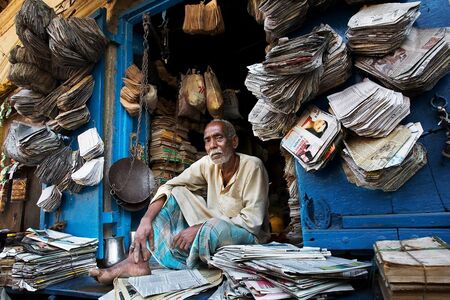Paper Bag is too sophisticated a term for our local ‘thonga’. The newspaper we sell are recycled and made into paper bags of all sizes. And the come in handy at the grocery shop and in all small shops until the plastic bags made their way. They were pushed out by their polluting cousins and how much the NGOs and Municipalities cry hoarse the plastics are here to stay.
At one time the 'thongas' dominated the scene and provided livelihood to poor women who made and supplied these from shop to shop earning a decent livelihood.Local boys on bicycle rickshaw collected newspaper and magazines from private houses and offices in the area and then women help construct the bags from recycled paper held together with 'lai',wheat flour local glue. The bags are stronger than they look, but had to be kept dry. Without the recycled logo they were an icon of recycling habit much before it was a fad. 'Thongas' are made of recycled paper and are readily recyclable.
In many old Calcutta paras there used to be ‘thonga masima’ , who took the newspapers from your home to craft it into small bags. At one point of time paper bag was a cottage industry particularly in the Baithukhana area near Rajabazar in Kolkata. The paper bag was made in small places like backyards or even at home with recycled newspaper.They came in different size and shapes grocery bags, bread bags,egg bags and other light duty bags having a single or multiple layer of paper.
A paper bag is a preformed container made of paper, with an opening at one end. It can be one layer of paper or multiple layers of paper. Today when we speak of paper bags we usually mean the more sophisticated type. A variety of constructions and designs are available. Many are printed with the names of stores and brands.Types of paper bag are laminated, twisted, flat tap. The laminated bag, whilst not totally waterproof, has a laminate that protects the outside to some degree.
Margaret E. Knight (1838-1914) was an employee in a paper bag factory when she invented a new machine part to make square bottoms for paper bags. Knight can be considered the mother of the grocery bag. She founded the Eastern Paper Bag Company in 1870. The first paper bag machine was patented by Francis Wolle in 1852.Francis Wolle was the inventor of a machine to make the square bottomed paper bags. Wolle was a botanist, clergyman, and a teacher, who apparently had the money to make a machine on a teacher’s salary. In 1872, Luther Crowell also patented a machine that manufactured paper bags. He patented the square bottomed paper bag. Luther acknowledged Knight as the true inventor, but declared that he had rights to make and sell the bag. He filed almost 300 patents for different styles of paper bags.
Incidentally,Bollywood actor Sanjay Dutt, who is serving his jail term in Pune, will be trained to make paper bags at the Yerawada Central Jail. Sanjay will get Rs 25 a day for this work. Sanjay Dutt is in jail for three years as he was held guilty by the supreme court in 1993 Mumbai terror attack. Sanjay will get a special training to make high quality, heavy duty paper bags with a capacity of 6-8 kg. Sanjay will get a daily remuneration of Rs 25. However, depending on the actors skills and efficiency, the payment may increase. Who knows when Sanjay comes out of jail there could be a Sanjubaba brand of 'thongas'?
I wish our own ‘thongas’ will make a comeback with the plastic bags banished for ever.

